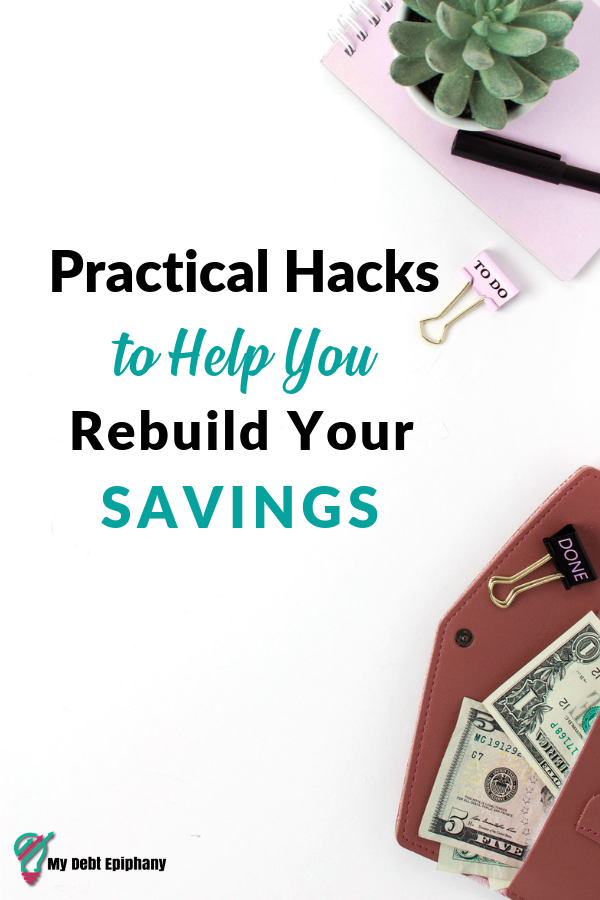How I’m Rebuilding ALL My Sinking Funds
So, last year something crazy happened and I drained most of my sinking funds. Last fall it was just one thing after another. My husband’s brakes in his car went out then my brakes went out. We have to do some maintenance work on the house, I took a trip in November which used up my travel savings, and of course, we used up all our holiday savings for Christmas.
I love having sinking funds because they allow me to save up for planned expenses over time and even cover some unexpected expenses with ease.
My emergency fund is still going strong so I’m not too worried, but I would like to rebuild all my sinking funds this year along with prioritizing debt payoff. Here’s what’s I’m doing and how you can rebuild your sinking funds as well.
Related: What Are Sinking Funds and How to Use Them
Spreading It Out
I have quite a few different sinking fund accounts to cover my spending for Christmas, travel, birthdays, home maintenance, vehicle registration fees, dental appointments, and out pets.
Needless to say, I have an account for each along with a goal savings amount. This is so important when you have sinking funds because it’s easy to just continually contribute money each month without an end goal in mind.
I actually stop funding my sinking funds when I’ve met my target goal. I know some people may not agree with this but what you do is totally up to you. Sometimes, I end up setting a new target savings goal. For example, my initial savings amount for my dental sinking fund is $1,000. Once I hit that goal, I may set another goal to save $500 – $1,000 more.
Knowing how much I want to set aside helps me stay motivated and spread things out if needed. I can also give myself a timeline. My Christmas sinking fund is constantly getting drained and built up each year so I know my timeline is 12 months.
If I want to save $800 each year for Christmas, I know that I can start adding at least $67 per month in that account. Spreading out your sinking fund contributions can make your goal seem more feasible and well-thought out. You may not hit your goal ASAP, but you’ll have a good idea regarding when your fund will be fully restored.
Related: 12 Frugal Hacks You Can Use to Start Saving Thousands
How to Achieve Goals You Set This Year
Using a High Yield Savings Account
This is a must for me. I switched from using my traditional bank to an online bank for my savings account a few years back and it was one of the best decisions I could have made.
I now keep all my sinking fund money in separate accounts in Capital One 360, an online high-yield bank account. My balances earn a 1% interest rate which is much more than the national average when it comes to brick and mortar banks.
Even though my accounts may earn a few dollars per month in interest, the more money I save, the higher my interest payments will get. Plus, accumulating small interest payments from my online bank is better than nothing and helps me increase my balance in the grand scheme of things.
Be sure to keep your sinking funds in a low or no fee bank account that offers a competitive interest rate. That way, you won’t lose your money to fees and can even earn interest.
Automating Savings
Automating your savings is one of the best ways to ensure you reach your goal. Once you adjust your budget to accommodate your sinking fund contributions, you can out saving on autopilot and set up automatic transfers each month. Right now, I’m deliberately putting $300 per month toward all my sinking funds.
I’m also finding additional money to set aside by using Digit.
Using Digit
Digit is a site that saves your spare change automatically. When you sign up for Digit, you connect it to your checking account so the Digit bot can study your spending.
Digit will monitor your account to see how much you’re spending in a typical week then it will determine how much they think you can save. From there, Digit will start automatically transferring some money from your checking account to a savings account. You can always transfer the money back to your checking account or even pause Digit’s transfers at any time.
The awesome part is that Digit does all the thinking for you. Sometimes, I tend to get caught up in a cycle of setting specific goals and only saving just enough to meet those goals. I started using Digit again about 2-3 months ago and it’s already helped me save over $100 (this is even after pausing the service for a few days each month when my spending got tighter). That’s $100+ of ‘spare money’ in my account that probably would’ve got blown on some other meaningless purchase had it not been automatically saved.
Digit Drawbacks
The main caveat with using Digit is that it’s $2.99 per month. They do offer you a free month, in the beginning, to try it out <— Definitely do this! If you struggle with saving and are looking for a mindless way to meet your savings goals, the small fee is worth it because you can save more money than you ever thought you could.
Digit is also not the best program for anyone who has a zero-sum budget meaning you budget down to zero each month. If you budget so precisely that every dollar you earn gets spent or put toward a specific expense, Digit may not work for you because there will be nothing left to save.
Still, if you have a budget, and keep your spending pretty flexible, Digit provides an effortless and painless way to start saving automatically. You never know until you give it a try.
Related: The Ultimate Guide to Budgeting
Budgeting With a Low Income, Yes It’s Possible
Since my income varies each month, so do my expenses which means I often have some breathing room in my budget to save more money. So far, using Digit has been a fun and spontaneous way for me to rebuild my sinking funds. It feels great to save extra money automatically that I never knew I had.
I also believe in having full emergency funds and I know this can be tough for many people to fill. To help you with this, I’ve put together a 4 part masterclass called ‘Build A Full Emergency Fund…FAST’ and it’s dedicated to all things emergency fund! We’ll dive into all the areas needed to get your emergency fund to where you want it to be fast.
We’ll discuss things such as your personal ‘why’ for building a full emergency fund, what you should and shouldn’t use emergency savings for, how many months of expenses you should set aside for your own personal situation and SO much more. I am also including great bonuses that will help you beyond the masterclass. Join the masterclass here!
Now, I’m super eager to hear from you.
Do you have sinking funds? If so, which categories did you choose and how do you fund them?

Stop Worrying About Money and Regain Control

Join 5,000+ others to get access to free printables to help you manage your monthly bills, reduce expenses, pay off debt, and more. Receive just two emails per month with exclusive content to help you on your journey.






